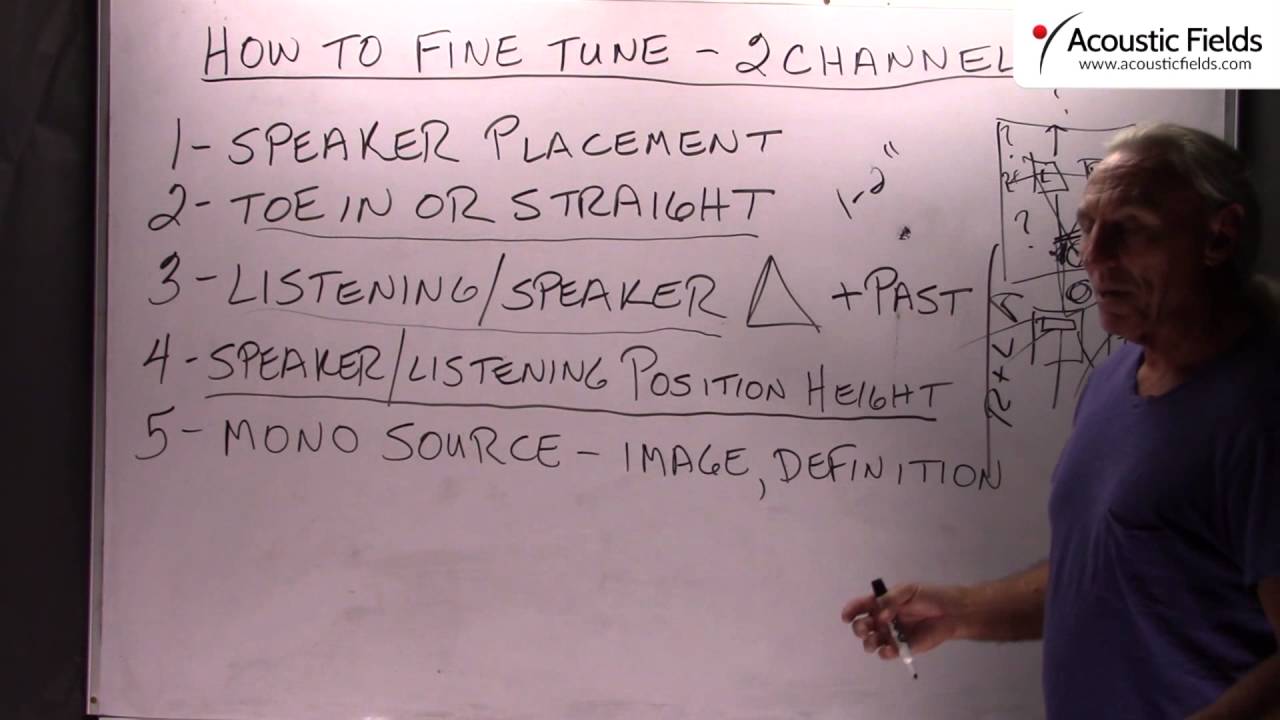Today we’re going to talk about how to fine tune your 2 channel system. First thing we have to decide is speaker placement. Now, we have a room and we’re going to put those speakers in a room. We have left and right, okay? How far from the front wall? How far from the sidewalls? How far from the listening position? These are all questions that have to be answered. And there is no one answer because everybody’s idea of definition and focus and sound stage is different. It’s a real subjective game.
So how do you decide? Well, you start with a given position and we can find that out for you. Just send us an email, give us your room size and volume and we’ll give you some good starting point. But the exact distance from the speakers, back of the speakers to the front wall, sidewalls and to the listening position has to be done through a fine tuning process. You move them a little bit, you start in one place, you mark it, you listen for a while.
Now, when you listen for a while give it a week or two. Don’t make a decision in one day that you like or don’t like something because our hearing changes with the amount of sleep we’ve got, the ability to perceive highs and mids change if you’re not feeling well. So give yourself a week or two with each position change. And move in small increments. Back and forward, right to left, you know, start with 2 inch increments, 1 to 2 inch increments, mark it with tape so you know where you started from, you know what you heard from that tape position and you can move forward, okay?
So toe in or straight? I get that a lot of times. It depends on this distance here between the sidewalls so that’s critical. It depends on your speakers. You know, if you have horns they have wide radiation pattern so you want to maybe put those straight, you might toe them in a little bit depending on the treatment that you have on the sidewalls, depending on rate and level of absorption that you have on the sidewalls so a lot of variables here. So experiment them. We usually toe in a little bit with our drivers but your situation might be completely different.
Speaker, listening the triangle obviously. You’ve heard a lot about that. That’s the equal distance from speakers to listening position between speakers that sidewall distances have to be equal. But there’s a magic spot behind the listening position also. And we have found that to be quite true in our studio here with big presentations, with big live presentations where there’s a lots of energy. Sometimes it’s better to be a little farther back in the presentation and open things up a little bit. Move forward for critical listening, showing some new music to a friend, listen to this guitar, listen to this drum. So there’s a variability here between – back and forth between the listening position and distance from the speaker.
Here’s another one that people kind if miss. Speaker / listening position height. Just because the speaker manufacture made the speaker to sit on the floor doesn’t mean that it has to stay on the floor. And if you use a little common sense in your room. And you sit on the floor and your speaker is here so you have the drivers here you’re going to get that first floor bounce. So if you elevate your listening position you’re going to change the angle of that bounce and smooth out the response. And you can do this with almost any room size and volume.
So don’t be afraid or don’t be afraid to elevate your listening position and your speaker position. Keep them together and the higher the ceiling obviously, the higher you can raise the position. So keep that in mind as another way to fine tune.
Mono source for tuning. Mono source will give you a great definition without the phase issues of stereo so you’ll be able to pinpoint the image with the mono source a lot clearer and use vocals. That’s the best way male vocals – we like male vocals in ours and tune it with the male and then bring in a female mono vocal. Ella Fitzgerald has a great mono album that we use a lot of times in our fine tuning.
So how to fine tune two channels? Speaker placement, toe in, the listening speaker triangle, speaker listening position and use a mono source. That will get you started. If you have any questions just email me.
—
This is an unedited transcript from our video series from Acoustic Fields. There will be some errors in grammar and sentence structure that occur during this translation process.
For complete understanding and comprehension, please view the video which is included in this text. For any additional information regarding this topic or others relating to room acoustics, please contact us directly at:
P: 520 – 392 – 9486







